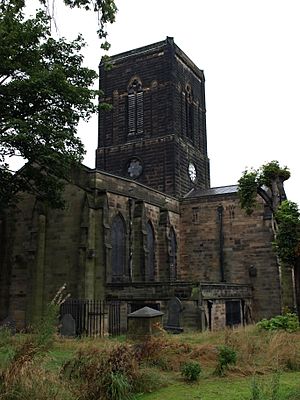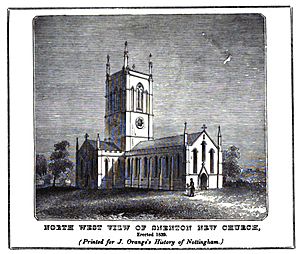St Stephen's Church, Sneinton facts for kids
Quick facts for kids St Stephen's Church, Sneinton |
|
|---|---|

St Stephen's Church, Sneinton, Nottingham
|
|
| Denomination | Church of England |
| Churchmanship | Contemporary Evangelical & Anglo Catholic |
| History | |
| Dedication | St Stephen |
| Administration | |
| Parish | Sneinton, Nottingham |
| Diocese | Southwell and Nottingham |
| Province | York |
St Stephen's Church, Sneinton, is an important local church in Nottingham, England. It is a parish church for the Sneinton area. This church is recognized as a Grade II listed building. This means it is a special building because of its history or architecture. The famous writer D. H. Lawrence's parents were married here on December 27, 1875.
Contents
History of St Stephen's Church
The story of St Stephen's Church goes back a very long time. It was first built in medieval times, which means the Middle Ages. For many years, priests from St. Mary's Church, Nottingham looked after it. St Stephen's became its own parish in 1866.
The church building you see today was finished in 1837. It was designed by a famous architect named Thomas Rickman. This building was one of the first in Nottinghamshire to be built in the Gothic Revival style. This style brought back ideas from medieval Gothic architecture. The church received money from the Church Building Commission to help pay for its construction. The total cost was about £4,511.
In the past, St Stephen's was known for its special church services. It was the first church in Nottingham to have a choir that wore white robes called surplices. This was a new idea at the time. The church was made bigger between 1909 and 1912. This work was done by Cecil Greenwood Hare based on designs by George Frederick Bodley.
After another church, St. Matthias' Church, Nottingham, closed in 2003, the parish of St Stephen's changed its name. It is now known as St Stephen and St Matthias.
The Church Clock
A new clock was put in the church tower in 1865. This clock has four faces, so you can see the time from different directions. It was a gift from William Tomlin and cost over £120. Since 1967, the Nottingham Corporation has been in charge of keeping the clock working. It is considered a public clock for everyone to use.
Special Features Inside the Church
The church has some beautiful and interesting features.
High Altar Reredos
Behind the main altar, there is a special decorated screen called a reredos. It was designed by George Frederick Bodley. This reredos was carved in Oberammergau, a town famous for its woodcarving. It shows different scenes from the life of Jesus Christ.
Ancient Choir Stalls
The seats where the choir sits are very old. They date back to the 1300s or 1400s. These choir stalls originally came from St. Mary's Church, Nottingham. The organist of St Stephen's bought them in 1848. They have special carvings underneath called misericords. These carvings show different figures and designs.
St Stephen's in the News
In 1959, St Stephen's Church was featured in a British Pathé newsreel. This was like an old-fashioned news report shown in cinemas. The newsreel showed Reverend John Tyson, the vicar at the time. He was encouraging young people to come back to church. The young people helped clean the church and attended evening services. In return, they were able to build a cafe and a rock 'n' roll club in the vicarage, which is the vicar's house.
The Church Organ
The church had a small pipe organ in 1840. This organ was sold in 1871. A new, bigger organ was bought for £450 in 1872. This new organ was made by Brindley & Foster. It was officially started on September 19, 1872. Herbert Stephen Irons, a famous organist from Southwell Minster, played it that day.
The organ was made even bigger in 1888. More work was done on it in 1901 by Cousans and Sons. They also moved it to a different part of the church. Later, Ernest Wragg and Sons did more work to keep it in good condition.
See also
- Listed buildings in Nottingham (Dale ward)


